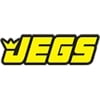Items You Need
| Ratings |
|---|
| Price |
| Brand |
Round Recirculating/Overflow Tank/Catch Cans
Features:
- Height: 9 in.
- Diameter: 3 in.
- Capacity: 27.50 oz.
- Can be used for recirculating or overflow applications
- JEGS exclusive "Just-A-Ble" system for easy mounting to radiator core support or custom brackets
Tank Comes Complete with:
- (2) 1/4 in.-28 x 3/4 in. Stainless Steel Hex Head Cap Screws
- (2) 1/4 in.-28 Stainless Steel Hex Nuts
- (2) 1/4 in. AN Stainless Steel Washers
- (2) 1/4 in. Stainless Steel Lock Washers
- (1) 1/4 in. NPT Petcock
- (2) 1/4 in. NPT x 3/8 in. 90 degree Brass Hose Barb Fittings
- (1) 1/4 in. NPT Breather Vent
- (1) #10-32 x 1/2 in. Stainless Steel Button Head Socket Cap Screw
- (1) 2-007 O-Ring N0670-74
Specifications:
I set this up as a recirculating catch can, fitting in bottom for overflow hose and the vent in the top when I shut the car down the can expels the antifreeze out the top vent it does not push it back into the radiator. Why won't it recirculate?
Motor Vehicles
WARNING: Motor vehicles contain fuel, oils and fluids, battery posts, terminals and related accessories which contain lead and lead compounds and other chemicals known to the State of California to cause cancer, birth defects and other reproductive harm. These chemicals are found in vehicles, vehicle parts and accessories, both new and as replacements. When being serviced, these vehicles generate used oil, waste fluids, grease, fumes and particulates, all known to the State of California to cause cancer, birth defects, and reproductive harm.
Tools:
WARNING: Some dust created by power sanding, sawing, grinding, drilling, and other construction activities contains chemicals known to the State of California to cause cancer and birth defects or other reproductive harm. Some examples of these chemicals are: lead from lead-based paints, crystalline silica from bricks and cement and other masonry products, and arsenic and chromium from chemically treated lumber. Your risk from exposure to these chemicals varies, depending on how often you do this type of work. To reduce your exposure, work in a well-ventilated area and with approved safety equipment, such as dust masks that are specially designed to filter out microscopic particles.
Electrical Cords
WARNING: The wires of these products contain chemicals known to the State of California to cause cancer and birth defects or other reproductive harm. Wash hands after handling.

![Round Recirculating/Overflow Tank/Catch Can [Billet Aluminum] Round Recirculating/Overflow Tank/Catch Can [Billet Aluminum]](http://www.jegs.com/images/photos/500/555/555-51136.jpg)




